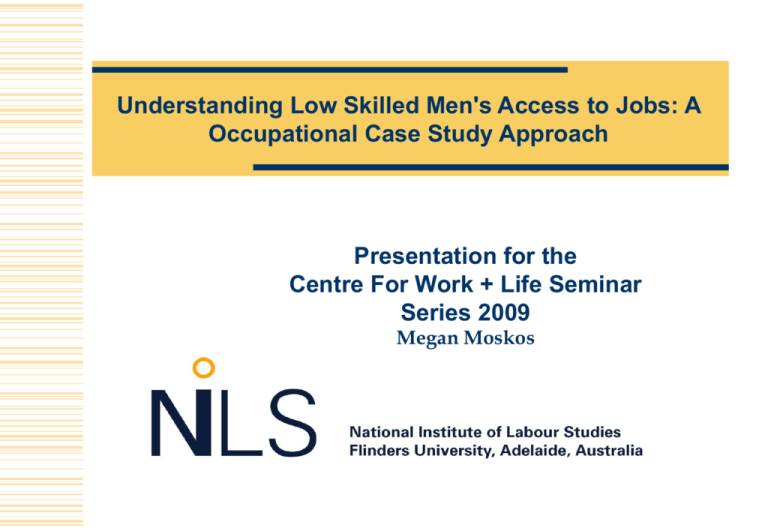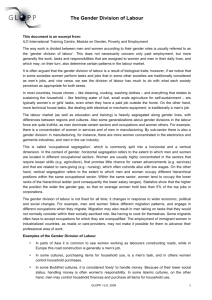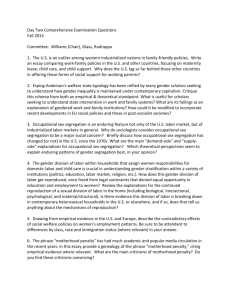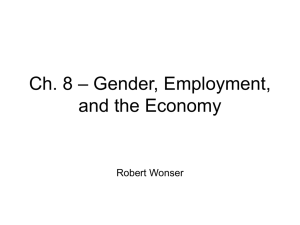Understanding Low Skilled Men's Access to Jobs
advertisement

Understanding Low Skilled Men's Access to Jobs: A Occupational Case Study Approach Presentation for the Centre For Work + Life Seminar Series 2009 Megan Moskos Outline of Presentation Why is this topic important? What does the literature say? What does this mean for future research? My research approach and initial impressions of the data Australia and its recent Economic Prosperity As of October 2008: Total employment reached a record high of 10,804,500 in trend terms (currently it stands at 10,786,000). and Unemployment rate was at a all time low (4.3%) (currently stands at 5.8%) However, many groups have not had a chance to share in this recent economic prosperity! Figure 1: Male Participation Rates by Age and Educational Attainment, 1981 and 2001 Male participation by age and education 1981 Source: Kennedy, S & Hedley, D (2003). Male participation by age and education 2001 Figure 1: Female Participation Rates by Age and Educational Attainment, 1981 and 2001 Female participation by age and education 1981 Source: Kennedy, S & Hedley, D (2003). Female participation by age and education 2001 Prime age males (25 to 54) participation rates, 1981-2006 census data 100 Per cent 90 Per cent Degree or higher Post-school 80 100 90 80 No post-school 70 70 60 60 50 50 40 40 1981 1986 1991 1996 2001 2006 Source: Steven Kennedy, Nicholas Stoney, Leo Vance, 2009 Should We Be Concerned? Men’s withdrawal from the labour force is placing a significant burden on the social security system through rising reliance on various pensions and job search allowances. Of the 712,500 men aged 25-64 who were not in the labour force in 2004, 386,900 received the DSP. Economically inactive men face a more severe range of socio-economic disadvantages compared to their employed counterparts. Men’s withdrawal from the labour force is occurring at the exact time Australia and other industrialised countries are facing increased pressure to raise participation rates to offset the economic and fiscal impacts of population ageing. Australia has the 6th lowest participation rates for men aged 25-54 of all OECD countries. Australia will forgo around two hundred and fifty billion in economic output due to male inactive over the next 45 years (Productivity Commission 2007). Why are Men Withdrawing from the Labour Market? Changing Industrial Structure and decline of traditional ‘male jobs’. Growth of Non-Standard Forms of Employment and Decline of Full-time Permanent Employment Skill-biased Technological Change Changing Industrial Structure Between 1994 and 2005, employment fell in net terms in three industries: manufacturing; electricity, gas and water; and wholesale. The majority of the employment loss in these industries was fulltime permanent positions held by men (Richardson & Liu, 2008). Between 1994-2005, 59% of new positions in Australia were in the service industries of property and business services, retail trade and health and community services. Most of the new jobs in these industries went to women. Employment growth for people with limited formal training has been concentrated in the service sector. Low level servicing jobs require different sets of skills and social attributes than those valued in manufacturing. Men are disadvantaged in their attempts to secure such jobs Men are reluctant to do low skilled service sector work due to the low wages and status of this work and the danger of compromising their masculinity Loss of Full Time Employment Of the 1.9 million jobs created during 1992-2005, 59% were nonstandard employment arrangements, being either part-time or casual or both (Richardson and Liu 2006). Non-standard employment is seen as compatible with many women’s employment aspirations or, at least, with their circumstances. Men less willing to take these non-standard forms of employment, as they are incompatible with traditional norms of masculinity and men’s prescribed breadwinner role. Skill Biased Technological Change Technological advances have combined with globalisation processes to reduced demand for workers with low skills and increase demand for those with higher skill levels In Australia over the period 1996-2005, 60% of the net new jobs created were for professionals and associate professionals. Over the same period labourers and related workers occupational category experienced a net loss of 18 800 workers. Elementary clerical, sales and service workers increased employment by 90 800 workers. Most of whom were women. Isn’t it more about Occupational Sex Segregation? Changing shape of Australia’s industrial structure, shifting skill demands, and changing employment contracts are major factors in the explanation of men’s withdrawal from the labour market only because of the gendered shape of the labour market and employment. Currently work for low skilled people is still being generated, however it is now being seen as the confines for low skilled female employment. The more accurate area of inquiry then, when attempting to understand why low skilled men are withdrawing from the labour market instead of taking advantage of available employment opportunities for workers with low levels of education, is occupation sex segregation. Occupational Sex Segregation: What is it? What is occupational sex segregation? the disproportionate concentration of men and women in particular occupations (jobs). two different forms: vertical and horizontal. Vertical: the extent to which women and men are unevenly distributed within an occupation. Horizontal: the extent to which women and men are unevenly distributed in different types of occupations. Recent Trends in Occupational Sex Segregation In the mid 1980s Australia held the title for the most sex segregated labour force in the OECD (Pocock, 1998) However, several changes have lead to expectations of a decline reduction and even reversal in gender differences in educational attainment a small but noticeable reallocation of domestic duties between men and women the introduction of legislative provisions to address sex discrimination in employment practices. First, after some dramatic reductions in occupational sex segregation in the 1970s and 80’s, recent evidence reveals that declines have stalled. Second, the declines have largely been in professional and managerial occupations. Third, declines largely reflect women’s movement into male dominated occupations. Fourth, men have entered women’s jobs very little at any occupational level. Why are men not moving into female dominated work?????? Occupational Sex Segregation: Why Does it Occur? Supply side (Human Capital Theory, Socialisation Theory) vs. Demand side (Employer Bias, Statistical Discrimination) Currently very little is known about how much occupational sex segregation arises because of demand side factors and how much arises from supply side decisions. Very little is also known about which side of the labour market process is generating or stalling change in levels of occupational sex segregation. In this way we don’t know if men’s limited inroads into female typed occupations is a reflection of choices made by the men themselves (supply side bottlenecks) or a result of discriminatory tastes of employers (demand side bottlenecks)? Explanations for Men’s Limited Inroads into Female Dominated Jobs Paula England’s explanation for asymmetries in gender change David Grusky (with various distinguished collaborators) and the decline of female advantaging essentialism Both explanations rest largely on supply side logic. Both theorists suggest that men are themselves choosing not to enter female jobs. Is this supply side assumption correct? The case of higher level jobs. Women’s movement into male occupations has primarily occurred at the upper end of the occupational spectrum. These occupations have experienced very strong employment growth over recent decades. Increased demand means that employers will be more willing to look at non-traditional sources of labour to ensure that vacancies are filled. This implies that declines in sex segregation in these occupations are largely a result of declines in demand side causes of occupational sex segregation (i.e. declines in employer discrimination). It is therefore reasonable to argue that any bottlenecks to occupational sex segregation represent supply side ones. Is this supply side assumption correct? The case of lower level jobs. Demand at the lower end of the labour market has been weak. The current choices faced by low skilled men is to either undertake the low level service work that is experiencing growth and therefore undertake work that is traditionally seen as women’s, or not to have work at all. Do low skilled men prefer to join the ranks of the unemployed rather than obtain employment in female jobs, as is implied in England and Grusky’s explanations? Or is there a level of demand side discrimination that exists for men at the lower end of the labour market that limits there ability to secure employment in the growing low level services sector? Currently there is little empirical research that test the claims made by Grusky and England. My Research Aim The aim: To understand the possible supply and demand side dimensions to men’s segregation from and conversely their integration into low level jobs that are experiencing employment growth. What are the factors that enabled men to successfully enter occupations characterised by gender bias? What are the factors that prohibit or hinder men to gain employment in these occupations? I aim to both contribute to an understanding of the processes that generate changes in male representation in female-dominated occupations and to explore the usefulness of various supply and demand side explanations as vehicles for theorizing about this type of occupational change. How I propose to do this Research centred around detailed case studies of four strategically chosen female dominated jobs where opportunities are increasing, and that are open to workers with limited formal education. 1996 and 2006 census data was used to locate female dominated occupations where employment had increased for workers with low levels of formal education and to ascertain how successful men had been in securing these jobs. The case study jobs: Child Care Workers Sale Assistants Aged or Disabled Carers Commercial Cleaners How I propose to do this Semi-structured interviews with: 10 or more male workers in each occupation 5 or more managers in each occupation 5 or more customer or clients of the service. Interviews with 25 men who are currently unemployed. Progress to Date Interviews Completed Aged Care 7 managers of aged care workers 2 focus groups with clients of aged care services 10 male aged care worker Child Care 6 manager of child care workers 5 clients of child care services 10 male child care worker Commercial Cleaning 1 male worker Unemployed Men 25 unemployed men Supply Side Story Unemployed Men Previous work experiences, skills and employment preferences strongly orientated them away from growing areas of low skilled service sector employment. majority hoped to obtain employment in jobs that have always been regarded as the male preserve. Unemployed men dislike for low level service work ‘Nah I wouldn’t be able to tolerate that. There’s too much nagging and kids carrying on. I couldn’t handle it. I would be a bit like Arnold Swarzernegger in Kindergarten cop’. Unemployed 3 ‘I couldn’t do it, no way. I don’t feel comfortable showering a man, that’s his privacy, let him shower himself’. Unemployed 5 Male Workers majority did not actively seek out this type of employment but instead stated that they somehow ‘fell into the job’. Supply Side Story Facilitating male employment easy to secure employment having high value placed on labour being subjected to more relaxed rules and expectations. Negating male employment Sexuality in question Threat to masculinity Suspicion about their sexual motivation Heighten surveillance of work activities and performance Feelings of inadequacy Low pay negates ability to sustain a family. Demand Side Story Facilitating male employment numerical rarity unique skills/benefits male workers offer. (innate) ability to be more authoritative gendered approach to work tasks Positive influence on the work environment Negating male employment Limited demand for them due to clients expectations and socially constructed notion of what sex is appropriate for the job. Overt discrimination to men entering the occupation. Conclusion Contrary to Grusky and England, there are a variety of factors operating on both the demand and supply side which both negate and facilitate men’s employment. Questions/comments/suggestions







